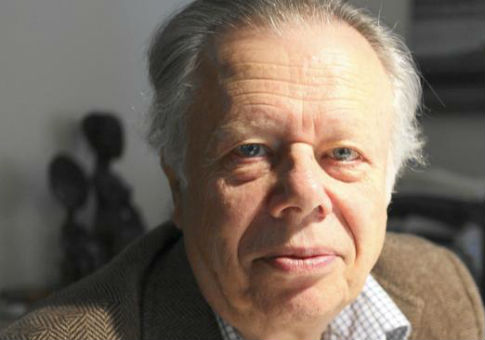"At the end of our time together," John Lahr writes in his profile of the director Mike Nichols, "he [Nichols] sat back on the sofa and declared himself pleased with the conversation. ‘I do well with the fundamentally inconsolable,’ I said. The words seemed to surprise Nichols and to press him back in his seat. His eyes fluttered shut for a moment, then opened. ‘We get a lot done, you know,’ he said."
I don’t know whether John Lahr, senior drama critic at The New Yorker for over twenty years, is fundamentally inconsolable but he has gotten a lot done in his life: ten biographical works, six works of criticism, two novels, and five plays. Like his father, Bert, who played both the Cowardly Lion in The Wizard of Oz and Estragon in Waiting for Godot, Lahr runs the gamut. He writes as well about David Rabe and the play Hurlyburly as he does about Nicolas Hytner’s production of Rodgers and Hammerstein’s Carousel; he has written biographies of Frank Sinatra and, of course, Dame Edna Everage (i.e., Barry Humphries).
This protean quality allows the reader to appreciate and understand, even if he doesn’t enjoy, or think he would enjoy, the works of the writers and directors being profiled. Tony Kushner, author of Angels in America and Caroline, Or Change, and his work have never interested me but after reading Lahr’s profile of him, I might give his work a try. Lahr gets so inside his subjects—usually putting together "a binder of about a thousand pages of interviews"—that unless you have no inkling of what Joyce meant when he said that he had never met a bore, you will not be put out reading Lahr.
Lahr tells us that his New Yorker pieces on playwrights and directors, 16 of which are included here,
allowed me to study the mystery of talent and the price of fame, two issues that bedeviled me as a child growing up in the household of a star.
In my mind, I am writing a sort of Lives of the Theatricals, doing for show people what my literary hero Dr. Samuel Johnson did for the poets of his day, commingling biography and criticism.
Lahr is interested in where the personal and creative meet. His approach, however, is not reductive: he does not say that, for example, David Mamet grew up in a verbally abusive household, ergo his plays show us that verbal abuse is bad. But he also wants to share with the reader the world and culture of theater, which he calls "an artisanal industry in a technological age."
Everything about it goes against the grain of our distracted, fast-moving cultural moment. A play requires the audience to work, to contend with eloquence and with ambiguity, to think. ... Theater is still the only popular entertainment in which you can hear a writer’s individual voice in stories undiluted by corporate agreement; in which language, in all its vulgar and vivacious permutations, is continually brought up to date; in which you can feel the carnal wallop of actors as they turn themselves inside out in the greatest show on earth, which is the show of human emotion.
He sees his mission as a drama critic to be one of providing a context for playgoers so that they may enjoy the theater better. "The more we know about the artists, the more we can appreciate their art."
That one I had to think about for a while. I finally decided it was mostly true, but that you have to qualify it with D.H. Lawrence’s dictum, "Trust the tale, not the teller." And sometimes Lahr seemed to me too mutable and thrillable. Only one predominantly negative review is included in the book. He seems never to have seen a play he didn’t love.
That said, Joy Ride, leaves one with a deeper understanding of how anything—even the fundamentally inconsolable—can be transmuted into the joy of artistic accomplishment.
